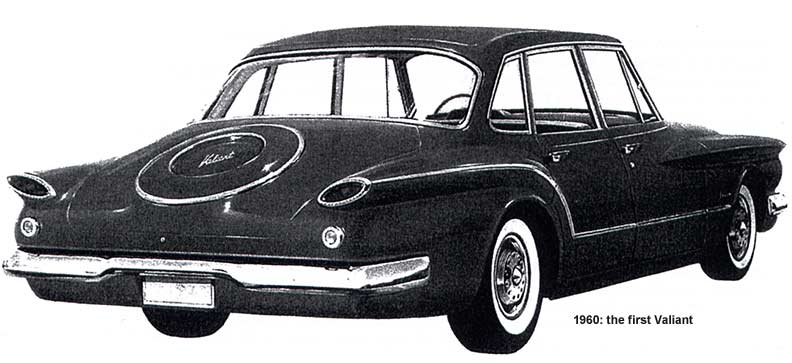Body and suspension
To prevent rust, a major problem of 1950s Chryslers, the company experimented and finally developed anti-rust measures including dipping all body parts in seven chemical baths, including one of zinc chromate. The success of this approach is shown by the number of good-condition first-generation Valiants.

The 1960 Valiant was two feet shorter, one foot narrower, and three inches lower than a 1960 regular-sized Plymouth. Doors were thinner than competitors, so that the interior was larger than cars of similar width. Despite being a "small" car, the Valiant could seat six comfortably, with 25 cubic feet of luggage space.
Chrysler had already begun its move to only making unit-body (monoque) cars, and the Valiant was happily included, for greater stiffness and lighter weight.
Don Gardner, writing in the Plymouth Bulletin, said that a scaled down version of the excellent Torsion-Aire front suspension system from full-size Chryslers was used, and that the Valiant was one of the first cars to have its suspension tested for loads and stress by computer. The front suspension had unequal length control arms and torsion bars running lengthwise to anchors beneath the front floor plan, while the rear suspension had semi-elliptica leaf springs (the number of springs varying with the engine and other options). The result was little brake dive and acceleration squat, with light steering even without power. American models had a steering box in front of the steering linkage, so that the pitman arm, idler arm, and steering knuckle all swung in the same direction, with a similar arc.
Those who drive an original Valiant may be amazed not just be the unusually good handling and smooth ride, but also by the quiet interior. This was done partly by the exensive use of sound proofing in the floor, roof, and firewall, and contributed to its solid feel. (Click here for 1960 Valiant notes and competitive comparisons.)
One surprising note is that the Valiant, ideal for export as it was, was not designed with right hand drive in mind. Thus, changes had to be made to the gear change lever, steering linkage, and steering box (which had to be moved at the back of the front suspension, with the linkage). The result was actually a lower number of turns lock to lock (3.2 rather than 5.2), but somewhat heavier steering. In addition, the oil filter had to be moved to make room for the steering box, and on the RV1 (R series) it ended up on the inner skirt panel. It was moved on the SV1 (S series) via long pipes halfway around to the left front of the motor, leading to a delay in building up oil pressure when the engine was started.
Throughout their life, there were at least two Valiant versions - a base model and a luxury version, whether called V200 or Signet or Brougham or another label. The exteriors were generally similar and differentiate with bits of trim or chrome.
In 1963, the Australian version, the AP5, had a revised rear to accommodate a larger trunk for more taxi sales.
Engines
The slant six engine was well tuned, with a very flat torque curve. To quote Don, "It was found that by increasing the width of the intake manifold, making each inlet tunnel almost equal length, it gave an increase in performance. Air-fuel mixture experiments on a standard manifold showed 9% less performance on a torque curve graph." This is likely the main reason why they slanted the engine 30 degrees - to make room for the manifold. There were other benefits, such as easier maintenance and less vibration - the carburetor was right there, with the dipstick.
The original 170 offered good economy, between the Corvair and the Falcon, and good performance potential, leading the Valiant to win the Mobil Gas Econonmy Run with nearly 28 mpg - though most owners saw the low 20s. To emphasize the performance of the small, high-revving engine, there were HyperPak engine kits available as dealer installed options to raise the small engine's output to 148 hp or more - some were said to get 185 hp out of it.
Meanwhile, the 225 - a 170 with one full inch of additional stroke - had better power than either of its main competitors, and became popular in Australia and the United States. There was also, later, a 198 cubic inch slant six. See Allpar's slant six page for details.
Additional engines were to include the entire LA V8 series (273, 318, 340, and, in the Volare and Diplomat, 360) and even the 383.
Transmissions
The standard and state of the art TorqueFlite transmission was lightened with an aluminum casing and made more compact, reslting in a savings of 100 pounds. In the first models, a pushbutton shifter (with cable operation) was used, with Park entered by sliding a lever. The three speed manual had a floor mounted, curved shifter.
Styling
Don Gardner noted in the Plymouth Bulletin: "Early in the Valiant's development, Chrysler rejected the notion that it would just be a scaled down version of a full-sized car. Instead, Chrysler's chief stylist Virgil Exner's goal was to build a car that was smaller and lighter without sacrificing passenger and luggage space. Thus, from the beginning, the interior was a high priority in the Valiant's creation."
The Valiant was completely new, though the grille came from the 1957 300C and the rear styling from the Imperial. Overall, the effect was unique, durable, and original.
Important Valiant Pages
- Valiant engineering, as written by project leader Robert Sinclair
- Valiant engineering and conceptual history
- Click here to see the Lotus Valiant!
- A detailed story on the Valiant's first year!

 Your Privacy Choices
Your Privacy Choices